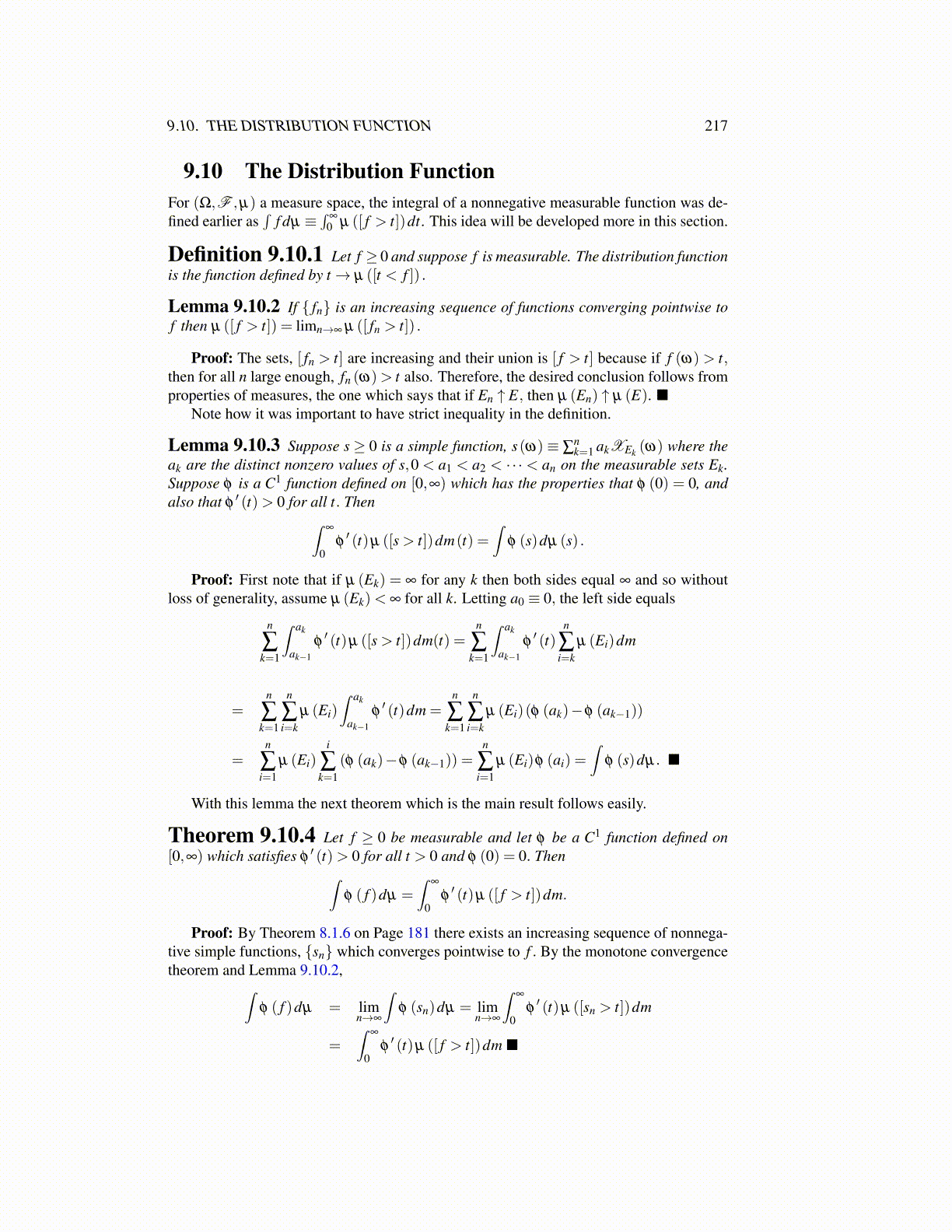
9.10. THE DISTRIBUTION FUNCTION 217
9.10 The Distribution FunctionFor (Ω,F ,µ) a measure space, the integral of a nonnegative measurable function was de-fined earlier as
∫f dµ ≡
∫∞
0 µ ([ f > t])dt. This idea will be developed more in this section.
Definition 9.10.1 Let f ≥ 0 and suppose f is measurable. The distribution functionis the function defined by t→ µ ([t < f ]) .
Lemma 9.10.2 If { fn} is an increasing sequence of functions converging pointwise tof then µ ([ f > t]) = limn→∞ µ ([ fn > t]) .
Proof: The sets, [ fn > t] are increasing and their union is [ f > t] because if f (ω) > t,then for all n large enough, fn (ω)> t also. Therefore, the desired conclusion follows fromproperties of measures, the one which says that if En ↑ E, then µ (En) ↑ µ (E). ■
Note how it was important to have strict inequality in the definition.
Lemma 9.10.3 Suppose s ≥ 0 is a simple function, s(ω) ≡ ∑nk=1 akXEk (ω) where the
ak are the distinct nonzero values of s,0 < a1 < a2 < · · · < an on the measurable sets Ek.Suppose φ is a C1 function defined on [0,∞) which has the properties that φ (0) = 0, andalso that φ
′ (t)> 0 for all t. Then∫∞
0φ′ (t)µ ([s > t])dm(t) =
∫φ (s)dµ (s) .
Proof: First note that if µ (Ek) = ∞ for any k then both sides equal ∞ and so withoutloss of generality, assume µ (Ek)< ∞ for all k. Letting a0 ≡ 0, the left side equals
n
∑k=1
∫ ak
ak−1
φ′ (t)µ ([s > t])dm(t) =
n
∑k=1
∫ ak
ak−1
φ′ (t)
n
∑i=k
µ (Ei)dm
=n
∑k=1
n
∑i=k
µ (Ei)∫ ak
ak−1
φ′ (t)dm =
n
∑k=1
n
∑i=k
µ (Ei)(φ (ak)−φ (ak−1))
=n
∑i=1
µ (Ei)i
∑k=1
(φ (ak)−φ (ak−1)) =n
∑i=1
µ (Ei)φ (ai) =∫
φ (s)dµ. ■
With this lemma the next theorem which is the main result follows easily.
Theorem 9.10.4 Let f ≥ 0 be measurable and let φ be a C1 function defined on[0,∞) which satisfies φ
′ (t)> 0 for all t > 0 and φ (0) = 0. Then∫φ ( f )dµ =
∫∞
0φ′ (t)µ ([ f > t])dm.
Proof: By Theorem 8.1.6 on Page 181 there exists an increasing sequence of nonnega-tive simple functions, {sn} which converges pointwise to f . By the monotone convergencetheorem and Lemma 9.10.2,∫
φ ( f )dµ = limn→∞
∫φ (sn)dµ = lim
n→∞
∫∞
0φ′ (t)µ ([sn > t])dm
=∫
∞
0φ′ (t)µ ([ f > t])dm ■